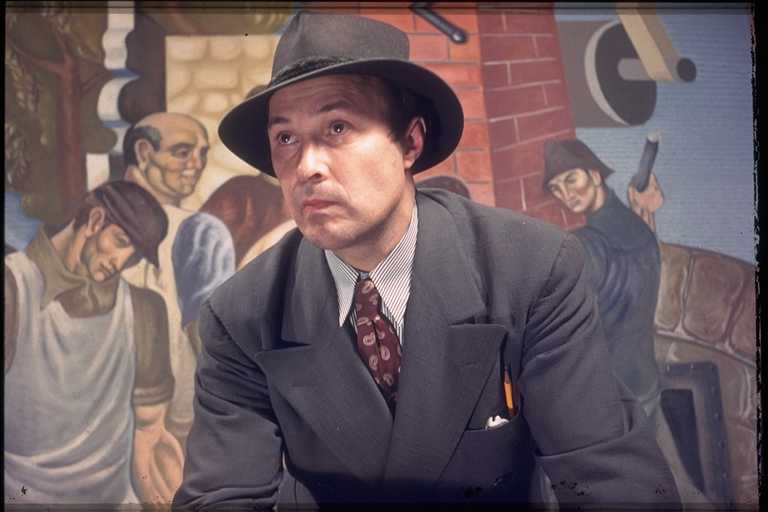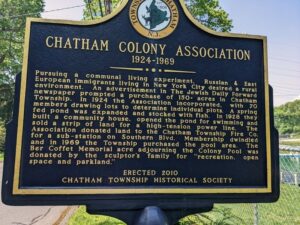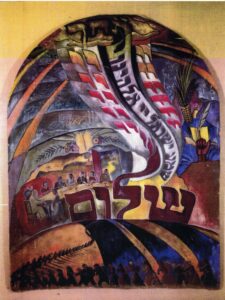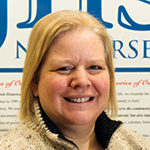
As we accept submissions for Community Connections: A Juried Art Exhibit in honor of our Centennial celebration, here’s a look back at the history of art – much of it by Jewish artists – in our Greater MetroWest community. Special thanks to Karen Blumenfeld for her contributions about the Chatham Colony Association.
Just over 110 years ago, a shift happened. A collective group in New York City introduced American audiences to European avant-garde styles at the International Exhibition of Modern Art held at the 69th Regiment Armory in 1913. This event marked a shift marking New York City as the unofficial art center of the world. Meanwhile, across the river, artists in Greater MetroWest were quietly creating works that also had a presence on the world stage.
Having spaces to showcase great works of visual art was incredibly important. In 1923, John Cotton Dana founded a new downtown space for Newark’s Museum of Art. Dana would include pieces from regional artists in the exhibits to attract local as well as global audiences to the museum. According to Morven Museum’s Roy Pedersen: “To his thinking, a good museum was an institution of visual instruction that would display products of its own place and time… People respond to regional art.”
Newark artists at the time studied at the Fawcett School or Newark’s Evening Drawing School whose faculty and alumni were part of the development of the American art scene. After meeting at the Fawcett School, art dealers Nathan Krueger and Bernard Rabin devoted their careers to showcasing American art, including Newark-based artists, for almost 40 years. Their gallery was established to reflect the “American scene as local artists portrayed it.”
During the Great Depression, many New Deal programs gave artists much needed work. Places like the Jersey Homestead in nearby Monmouth County and Chatham Colony Association established communal living and attracted an impressive group of artists.
 The Chatham Colony became home to two Russian immigrant Jewish artists. Ber Coffet specialized in sculpture of wood, marble, and bronze. In his Colony studio he created wooden figurines and bowls out of local trees. One of his sculptures still stands on the original property. Ber had a following, selling his creations to locals from his home studio.
The Chatham Colony became home to two Russian immigrant Jewish artists. Ber Coffet specialized in sculpture of wood, marble, and bronze. In his Colony studio he created wooden figurines and bowls out of local trees. One of his sculptures still stands on the original property. Ber had a following, selling his creations to locals from his home studio.
Israel (aka Isa) Katz, a gifted portrait artist, sculptor, and fine arts instructor, moved to The Colony in 1926 at the suggestion of his art school friend Ber. He designed and decorated fine china, painting gold leaf on china and silver leaf on glass for a New York City manufacturer.
Summer camp at The Colony pool included creative art classes for children. Blanche Thorner Blumenfeld, daughter of original Colony members Louis and Clara, applied her art skills to create signage marketing her family’s chicken business at The Colony. The Colony fostered artistic creativity amongst all its residents, regardless of age.
In the 1930s Ben Shahn attracted the attention of the Works Progress Administration (WPA) and the Farm Securities Administration (FSA) and moved to Jersey Homesteads to create a mural at Roosevelt Elementary School. Ben and his wife Bernarda completed a 45-foot fresco depicting the history of the Jersey Homesteads. Jersey Homesteads was created primarily to resettle Jewish garment workers as an integrated project, with farming, manufacturing, and retail all on a cooperative basis.
 Artist Michael Lenson (pictured at top) became the director of WPA mural projects for New Jersey and his works can be found at Newark City Hall, The Verona Sanitarium, and Weequahic High School. After paying a visit to Elizabeth NJ’s Y, artist A. Raymond Katz offered to paint murals to fill empty spaces in the building. Ruth Brewster, daughter of Harry and Mary Lebau, recalls: “Katz saw the empty spaces and said, ‘I can do murals for you to fill them,’ and my father said, ‘How much would you charge per mural?’ Katz said $100. So, my father plunked down $25 from his pocket,” — during the Depression, that was real money — “and he said, ‘We need them.’ These enormous Judaica-themed murals were donated to the JHS and will hopefully be displayed in the future.
Artist Michael Lenson (pictured at top) became the director of WPA mural projects for New Jersey and his works can be found at Newark City Hall, The Verona Sanitarium, and Weequahic High School. After paying a visit to Elizabeth NJ’s Y, artist A. Raymond Katz offered to paint murals to fill empty spaces in the building. Ruth Brewster, daughter of Harry and Mary Lebau, recalls: “Katz saw the empty spaces and said, ‘I can do murals for you to fill them,’ and my father said, ‘How much would you charge per mural?’ Katz said $100. So, my father plunked down $25 from his pocket,” — during the Depression, that was real money — “and he said, ‘We need them.’ These enormous Judaica-themed murals were donated to the JHS and will hopefully be displayed in the future.
There are world famous art pieces throughout the community, including the Robert Motherwell, Herbert Ferber, and Adolph Gottlieb pieces commissioned by Congregation B’nai Israel of Millburn; the Tiffany stained glass in the Ballantine and Fiegenspan Mansions and St. John’s Episcopal Church; the paintings by John Less in the Aidekman Campus in Whippany, NJ; and the art deco gems scattered throughout Newark, Elizabeth, and other cities.
The Greater MetroWest art movement of the early 20th century never went away – it has evolved with the times and has become emblematic of our story of survival and hope. Today the Greater MetroWest community can view local artists’ works at the annual Gaelen Juried Art Show and members can participate in the JSDD’s WAE (Wellness, Arts and Enrichment) Arts Program and local JCC’s arts programs. We invite all local artists to participate in our Centennial Community Art Exhibition by submitting work here.
If you would like to share your story and connect with the Jewish Historical Society of Greater MetroWest NJ, contact Karen Bocaletti at kbocaletti@jfedgmw.org or call (972)929-2954.

